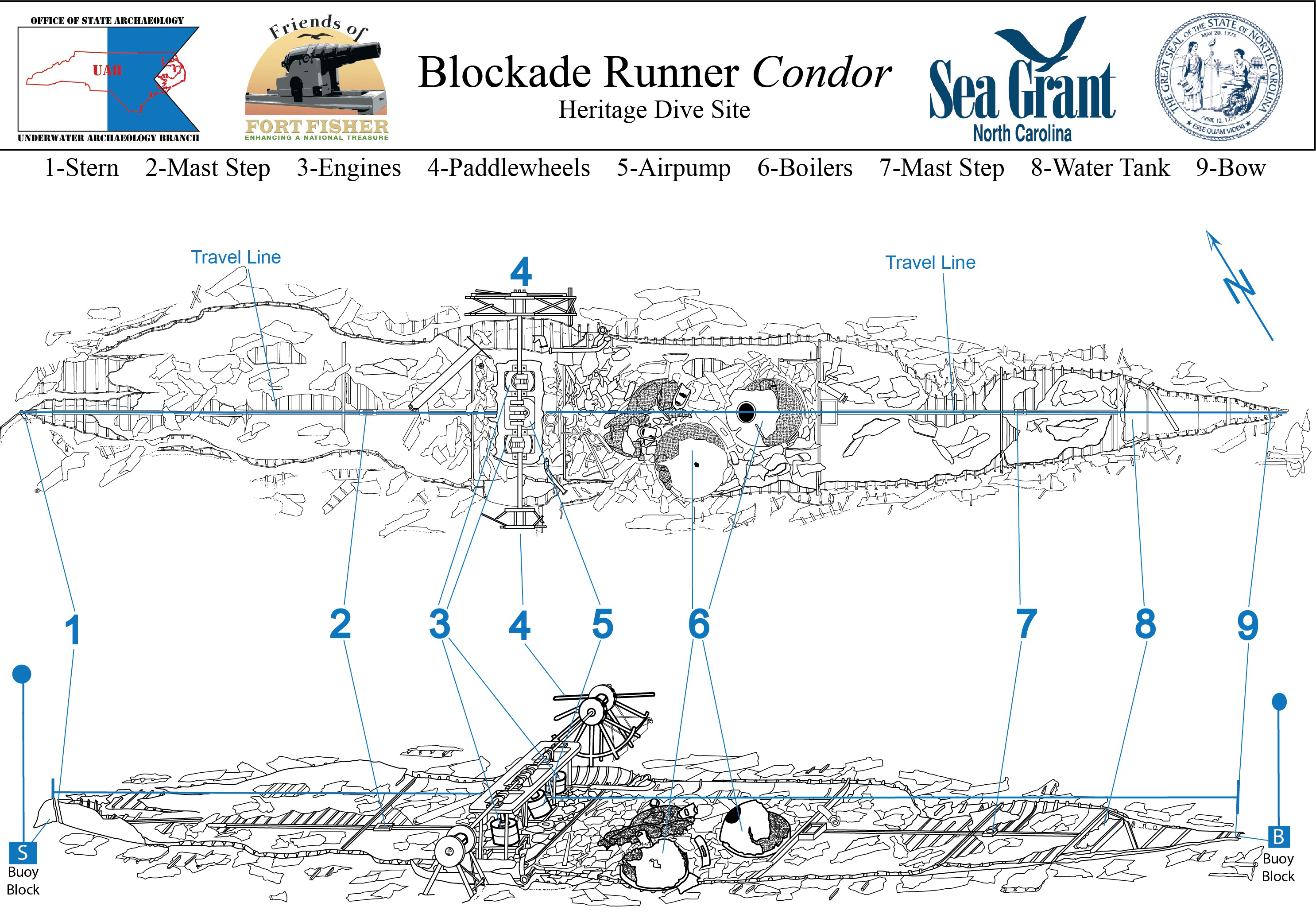North Carolina Opens First Heritage Dive Site
Photo: Divers are able to see and touch remaining parts of the shipwreck, like the engines, shown above. Photo courtesy of N.C. Department of Natural and Cultural Resources.
By Danielle Costantini
We’ve all heard of a walk in the park, but what about a dive in the park?
Starting Friday, June 16, Kure Beach will be home to North Carolina’s first Heritage Dive Site. It will feature the American Civil War blockade-runner, the Condor.
North Carolina’s Office of State Archaeology’s Underwater Archaeology Branch, or UAB, intends to turn this valuable maritime resource into an in-sea museum.
“This project is the result of some amazing teamwork between our Underwater Archaeology Branch, historic site, maritime museum and aquarium staff, along with some truly outstanding community partners such as North Carolina Sea Grant and Friends of Fort Fisher,” notes Secretary Susi H. Hamilton of the N.C. Department of Natural and Cultural Resources.
North Carolina Sea Grant is providing research funding to help further understand the preservation efforts of sites like the Condor, which are nonrenewable, cultural resources.
The UAB wants to preserve these submerged sites, but also to use them for education and tourism. Florida has 12 heritage dive sites that have enabled the state to further protect these underwater resources.

The ship rests in about 25 feet of water, roughly 700 yards off the beach in front of the North Carolina Aquarium at Fort Fisher. The almost-complete, 218-foot-long wreckage is easily accessible by snorkelers or divers.
As the Union navy barricaded the North Carolina coast, blockade-runners like the Condor would attempt to outmaneuver and outrun Union ships to get to the Confederate-held coastline. The Condor was run aground on its maiden journey from England the night of Oct. 1, 1864.

Confederate spy Rose O’Neal Greenhow was a passenger aboard the ship. She was returning from England where she had spent years in exile and garnering support for the Southern cause. As the Condor ran aground, Greenhow insisted upon being rowed to shore, over the objections of the ship’s officers, to avoid capture by Union forces. Her lifeboat overturned, and Greenhow drowned. She is buried in Oakdale Cemetery in Wilmington, N.C.
Shipwrecks are not uncommon on the North Carolina coast — archaeologists have located almost 1,000 out of an estimated 4,900 sunken ships. For this reason, many call the N.C. coastline the “Graveyard of the Atlantic.”
In-sea museums function similarly to those on land. They allow history to be brought to life, for visitors to see and touch things of the past. To assist snorkelers and divers, the UAB has mapped the Condor. Visitors will be able to navigate the lower hull, engines, paddle wheels and boilers. Directional dive slates, buoys and maps will assist those swimming through the self-guided tour. Informational signs are in place so that visitors learn about the history that makes this site so special.
For those that are land-bound, the Fort Fisher State Historic Site visitor’s center and the N.C. Aquarium at Fort Fisher offer pictures, replicas and information about the ship.
Sea Grant is working with UAB to help continue sustainable use of underwater resources. “We are very excited about the new heritage site and hope that it will bring awareness to coastal issues around the state,” notes John Fear, deputy director of Sea Grant.
A minigrant provided by Sea Grant will fund a collaborative effort between the UAB and East Carolina University graduate student, Hoyt Alexander. The project will compare the effects of corrosion on the iron-hulled Condor and the steel-hulled Stormy Petrel, which sank 850 yards away. This research, combined with ongoing efforts of the American Battlefield Protection Project grant from the National Park Service that monitors sediment transport, will allow for a better understanding of underwater site preservation.
The UAB plans to develop a Heritage Dive Trail on the North Carolina coast with additional dive sites.
If interested in visiting the Condor or other similar sites, remember: “Take pictures, leave bubbles.”
A dedication event will take place Friday, June 16, to celebrate the opening of the heritage dive site.
For more information about the work that has gone into creating the site, visit https://ncseagrant.ncsu.edu/currents/2016/06/creating-an-in-sea-museum/.
- Categories:


